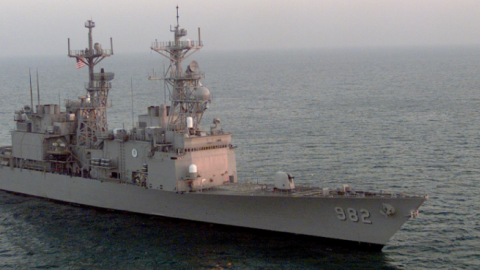Sen. Tom Cotton (R-Ark.) has released a report on the U.S. Navy’s surface combatant fleet culture. The think tank and analysis community, and the foreign policy establishment more broadly, tend to avoid these sorts of cultural investigations, preferring to conduct systems analyses that rely on empirical figures and weapons system data. So assessments like those undertaken by Sen. Cotton along with Reps. Jim Banks (R-Ind.), Dan Crenshaw (R-Texas) and Mike Gallagher (R-Wis.) are, therefore, critical to understanding the state of the Navy today.
Moreover, the focus on the surface fleet draws attention to a structural issue within the sea services. Even after the rise of the Carrier Air Wing during World War II, followed by the nuclear submarine revolution, the Navy’s surface combatants retained a critical offensive role throughout the Cold War. The surface fleet was expected to take the fight to the enemy, hunting down Soviet submarines in the central Atlantic, defending U.S. and allied merchant shipping, and pressuring Soviet surface ships and submarines that defended the USSR’s naval bastions in the Barents Sea and the Sea of Okhotsk.
Since the Cold War, however, budgetary constraints and shifting missions forced the Navy to redefine its strategic purpose. Rather than achieving sea control against a great-power navy and using it to assault an adversary’s vulnerable maritime flanks, it was tasked with supporting ground operations against targets with little to no naval forces. This resulted in the prioritization of the Navy’s nuclear submarines, particularly its ballistic-missile boats that still ensure an American second-strike, and ground-attack aviation. And this occurred at the expense of the surface fleet.
Nominally, Navy surface combatants were still responsible for defending carrier strike groups against air, surface, and subsurface threats. But surface combatants have a limited missile arsenal that overwhelmingly tilts towards ground-attack, much like the shrinking Carrier Air Wing. Indeed, the five-inch deck gun is one of the Arleigh Burke-class destroyers’ primary anti-ship weapons.
The Cotton report addresses the results of this squeeze. It argues that seemingly isolated incidents — the Bonhomme Richard fire and subsequent scrapping last summer, the Fitzgerald and McCain collisions, and Iran’s 2016 capture of two fast-attack craft and 10 U.S. sailors — increasingly reflect a broader trend of cultural neglect. Multiple issues are at play. The modern Navy has been asked to take on similar responsibilities to its Cold War predecessor, despite fielding approximately half as many ships and without a commensurate budget increase. The repeated disasters of the late 1980s and the 1990s, most notably the Iowa’s turret explosion, the Tailhook scandal and the suicide of Chief of Naval Operations Mike Boorda, did not help the service’s credibility.
These nourished a culture of risk-aversion that, paradoxically, meshes with the modern media’s focus on moral and ideological purity. This reinforces the surface Navy’s inherent conservatism: The fleet generally does not tolerate major mistakes, despite the clear lapses in judgment and what would today be deemed problematic character of several WWII-era five-star admirals. These pressures lead to bizarre outcomes — for example, where Commander Frank Azzarello is relieved for attempting to boost his sailors’ morale with the display of a captured enemy rifle, and grey hulls sport layers of rust, and all the while the Navy persists in “diversity and inclusion” efforts as mandated by the current administration.
One should not, however, place all blame at the Navy’s feet. Budgetary choices are largely out of its hands: Congress and successive administrations have failed to recognize the critical role the Navy plays in national defense, and the service is attempting to meet responsibilities while grossly undermanned. Under these circumstances, compromises are inevitable. Moreover, the lasting malignant consequences of reform legislation enacted 35 years ago diminishes the ability of the Navy to craft strategy as it did before WWII and during the Cold War.
Indeed, the issue is not restricted to cultural or budgetary problems. It is strategic.
The role of the sea services in modern American strategy relies on a prior, broader question, that of American strategy itself. The United States is a maritime nation in interest, not in culture. Since the Republic’s founding, the American economy has relied upon international trade, first as an exporter of cotton, timber, steel and coal, and then as an importer of raw materials and producer of refined goods; even the modern financialized U.S. economy requires steady economic circulation. America has a vested interest in global economic stability and, by extension, global commercial access.
Ensuring this objective, in turn, requires denying any hegemonic power or coalition domination of the Eurasian landmass, upon which most humans live, within which most of the world’s raw materials are located, and around which the majority of critical maritime chokepoints can be found. Naval power is critical to achieving this end. Only through naval power can the chokepoints that dominate maritime trade be policed. And only through naval power can the U.S. project the rest of its strength to other shores.
The Sino-American antagonism fits into this same scheme. China’s objective is to dominate the Indo-Pacific and use this hegemony to manipulate international trade. Achieving this dominance will require maritime supremacy — hence China’s expanding navy and national merchant fleet. A Sino-American conflict will, therefore, likely be a naval conflict, a sea war akin to those of the 18th century between England and the Netherlands, or the bulk of the Pacific War against Japan.
Sen. Cotton and his congressional colleagues found that the Navy is insufficiently prepared to fight and win a great-power conflict with China; it would be foolish to ignore and fail to address those findings. But the deeper issue of strategy remains. Unless the sea services, and the U.S. policy establishment more broadly, can articulate a coherent vision linking military capabilities to political effects, military resolve will be irrelevant. That is, it will drive thousands of young men and women to their deaths at Chinese hands.
Chinese Communist Party Leader Xi Jinping has no confusion of objective, nor any misunderstanding of the price that power demands.















